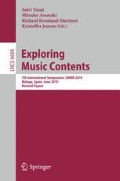Abstract
The study of musical expressivity is an active field in sound and music computing. The research interest comes from different motivations: to understand or model music expressivity; to identify the expressive resources that characterize an instrument, musical genre, or performer; or to build synthesis systems able to play expressively. Our research is focused on the study of classical guitar and deals with modeling the use of the expressive resources in the guitar. In this paper, we present a system that combines several state of the art analysis algorithms to identify guitar left hand articulations such as legatos and glissandos. After describing the components of our system, we report some experiments with recordings containing single articulations and short melodies performed by a professional guitarist.
Access this chapter
Tax calculation will be finalised at checkout
Purchases are for personal use only
Preview
Unable to display preview. Download preview PDF.
References
Arcos, J.L., López de Mántaras, R., Serra, X.: Saxex: a case-based reasoning system for generating expressive musical performances. Journal of New Music Research 27(3), 194–210 (1998)
Brossier, P.: Automatic annotation of musical audio for interactive systems. Ph.D. thesis, Centre for Digital music, Queen Mary University of London (2006)
Brossier, P., Bello, J.P., Plumbley, M.D.: Real-time temporal segmentation of note objects in music signals. In: Proceedings of the International Computer Music Conference, ICMC 2004 (November 2004)
Burns, A., Wanderley, M.: Visual methods for the retrieval of guitarist fingering. In: NIME 2006: Proceedings of the 2006 conference on New interfaces for musical expression, Paris, pp. 196–199 (June 2006)
Carlevaro, A.: Serie didactica para guitarra. vol. 4. Barry Editorial (1974)
de Cheveigné, A., Kawahara, H.: Yin, a fundamental frequency estimator for speech and music. The Journal of the Acoustical Society of America 111(4), 1917–1930 (2002)
Dodge, C., Jerse, T.A.: Computer Music: Synthesis, Composition, and Performance. Macmillan Library Reference (1985)
Duxbury, C., Bello, J., Davies, J., Sandler, M., Mark, M.: Complex domain onset detection for musical signals. In: Proceedings Digital Audio Effects Workshop (2003)
Erkut, C., Valimaki, V., Karjalainen, M., Laurson, M.: Extraction of physical and expressive parameters for model-based sound synthesis of the classical guitar. In: 108th AES Convention, pp. 19–22 (February 2000)
Gabrielsson, A.: Once again: The theme from Mozart’s piano sonata in A major (K. 331). A comparison of five performances. In: Gabrielsson, A. (ed.) Action and perception in rhythm and music, pp. 81–103. Royal Swedish Academy of Music, Stockholm (1987)
Gabrielsson, A.: Expressive intention and performance. In: Steinberg, R. (ed.) Music and the Mind Machine, pp. 35–47. Springer, Berlin (1995)
Gouyon, F., Herrera, P., Gómez, E., Cano, P., Bonada, J., Loscos, A., Amatriain, X., Serra, X.: In: ontent Processing of Music Audio Signals, pp. 83–160. Logos Verlag, Berlin (2008), http://smcnetwork.org/public/S2S2BOOK1.pdf
Grachten, M., Arcos, J., de Mántaras, R.L.: A case based approach to expressivity-aware tempo transformation. Machine Learning 65(2-3), 411–437 (2006)
Heijink, H., Meulenbroek, R.G.J.: On the complexity of classical guitar playing:functional adaptations to task constraints. Journal of Motor Behavior 34(4), 339–351 (2002)
Johnstone, J.A.: Phrasing in piano playing. Withmark New York (1913)
Juslin, P.: Communicating emotion in music performance: a review and a theoretical framework. In: Juslin, P., Sloboda, J. (eds.) Music and emotion: theory and research, pp. 309–337. Oxford University Press, New York (2001)
Lee, N., Zhiyao, D., Smith, J.O.: Excitation signal extraction for guitar tones. In: International Computer Music Conference, ICMC 2007 (2007)
Lin, J., Keogh, E., Wei, L., Lonardi, S.: Experiencing sax: a novel symbolic representation of time series. Data Mining and Knowledge Discovery 15(2), 107–144 (2007)
Lindström, E.: 5 x oh, my darling clementine the influence of expressive intention on music performance (1992) Department of Psychology, Uppsala University
de Mantaras, R.L., Arcos, J.L.: Ai and music from composition to expressive performance. AI Mag. 23(3), 43–57 (2002)
Masri, P.: Computer modeling of Sound for Transformation and Synthesis of Musical Signal. Ph.D. thesis, University of Bristol (1996)
Norton, J.: Motion capture to build a foundation for a computer-controlled instrument by study of classical guitar performance. Ph.D. thesis, Stanford University (September 2008)
Palmer, C.: Anatomy of a performance: Sources of musical expression. Music Perception 13(3), 433–453 (1996)
Radicioni, D.P., Lombardo, V.: A constraint-based approach for annotating music scores with gestural information. Constraints 12(4), 405–428 (2007)
Radisavljevic, A., Driessen, P.: Path difference learning for guitar fingering problem. In: International Computer Music Conference (ICMC 2004) (2004)
Sloboda, J.A.: The communication of musical metre in piano performance. Quarterly Journal of Experimental Psychology 35A, 377–396 (1983)
Trajano, E., Dahia, M., Santana, H., Ramalho, G.: Automatic discovery of right hand fingering in guitar accompaniment. In: Proceedings of the International Computer Music Conference (ICMC 2004), pp. 722–725 (2004)
Traube, C., Depalle, P.: Extraction of the excitation point location on a string using weighted least-square estimation of a comb filter delay. In: Procs. of the 6th International Conference on Digital Audio Effects, DAFx 2003 (2003)
Author information
Authors and Affiliations
Editor information
Editors and Affiliations
Rights and permissions
Copyright information
© 2011 Springer-Verlag Berlin Heidelberg
About this paper
Cite this paper
Özaslan, T.H., Guaus, E., Palacios, E., Arcos, J.L. (2011). Identifying Attack Articulations in Classical Guitar. In: Ystad, S., Aramaki, M., Kronland-Martinet, R., Jensen, K. (eds) Exploring Music Contents. CMMR 2010. Lecture Notes in Computer Science, vol 6684. Springer, Berlin, Heidelberg. https://doi.org/10.1007/978-3-642-23126-1_15
Download citation
DOI: https://doi.org/10.1007/978-3-642-23126-1_15
Publisher Name: Springer, Berlin, Heidelberg
Print ISBN: 978-3-642-23125-4
Online ISBN: 978-3-642-23126-1
eBook Packages: Computer ScienceComputer Science (R0)

